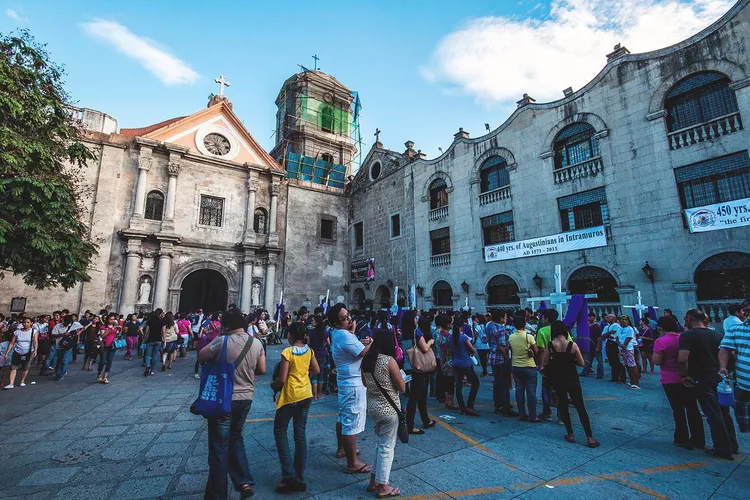Summary
The San Agustin Church: A Historical Landmark in Manila
In the Philippines, the San Agustin Church in Intramuros, Manila stands resilient. This grand Baroque structure, completed in 1606, has weathered numerous earthquakes, invasions, and typhoons. Despite the destruction wrought by World War II on the rest of Intramuros, San Agustin Church remains intact.
Visitors today can admire features that survived notably intact: the High Renaissance façade, exquisite trompe l’oeil ceilings, and a museum within the former monastery showcasing ecclesiastical relics and art.
History of the San Agustin Church
The arrival of the Augustinian order marked the beginning of their mission in the Philippines. They initially established a small church made of thatch and bamboo, named the Church and Monastery of Saint Paul in 1571. However, this structure was soon destroyed by fire following an attack by the Chinese pirate Limahong in 1574. A second wooden church also met the same fiery fate.
After two failed attempts, the Augustinians succeeded with a stone church completed in 1606, which has withstood the test of time.
For over four centuries, San Agustin Church has witnessed Manila’s tumultuous history. Notably, the founder of Manila, Spanish conquistador Miguel Lopez de Legaspi, was buried on this site, although his remains were later disturbed during the British sacking of the church in 1762.
In 1898, as the Spanish surrendered to American forces, negotiations took place in the church’s vestry.
The San Agustin Church during World War II
During the recapture of Manila by American forces from the Japanese in 1945, tragic events unfolded at San Agustin Church. The retreating Imperial troops committed heinous acts, resulting in the massacre of unarmed clerics and worshipers within the church’s crypt.
While the church structure itself survived, the monastery did not; it was destroyed in a fire but has since been reconstructed. In 1973, the monastery was transformed into a museum displaying religious artifacts and treasures.
Notably, in 1994, along with a few other Baroque churches in the Philippines, San Agustin Church was designated a UNESCO World Heritage Site. A significant renovation project, funded partly by the Government of Spain, is planned for the church in the coming years. (source)
Architecture of the San Agustin Church
The architectural design of San Agustin Church reflects the influence of churches built by the Augustinians in Mexico, with necessary adaptations for local weather conditions and the construction materials available in the Philippines.
Consequently, while the façade is simpler than typical Baroque structures, it still features distinctive elements such as Chinese “fu” dogs in the courtyard, symbolizing the cultural blend in the Philippines, and intricately carved wooden doors.
Upon entering the church, visitors are drawn to the stunning ceiling crafted by Italian artists Alberoni and Dibella. The trompe l’oeil designs enliven the space with intricate geometric patterns and religious themes, achieving a three-dimensional illusion entirely through artistry.
At the rear of the church, a gilded retablo commands attention, complemented by a similarly adorned pulpit, showcasing the authentic essence of Baroque artistry.
The Museum of the San Agustin Church
The museum, located in the church’s former monastery, features a rich collection of religious artworks, relics, and ecclesiastical items from its historical journey, with the oldest pieces tracing back to the city’s founding days.
One significant artifact is a 3-ton bell, the only surviving remnant of a bell tower destroyed by an earthquake, inscribed with the phrase, “the Most Sweet Name of Jesus.” The receiving hall (Sala Recibidor) showcases ivory sculptures and embellished church artifacts.
As visitors explore various halls, they encounter oil paintings of Augustinian saints alongside traditional processional carriages (carrozas). The old Vestry (Sala de la Capitulacion) retains more church-related items, while the Sacristy features practical artifacts such as Chinese-made chest drawers and Aztec doors.
Moreover, the former refectory, converted into a crypt, honors the memory of victims of atrocities committed by the Japanese Imperial Army, marking the site where numerous lives were lost.
Upstairs, the monastery’s library and additional rooms are accessible, including a space leading to the church’s choir loft, which houses a historic pipe organ.
The museum charges an entrance fee of P100 (approximately $2.50) and operates from 8 AM to 6 PM, with a lunch break from 12 noon to 1 PM.





